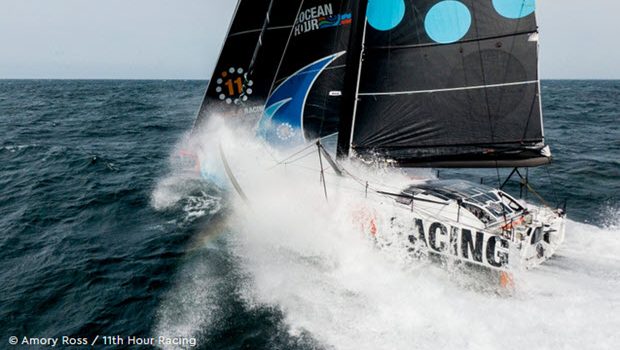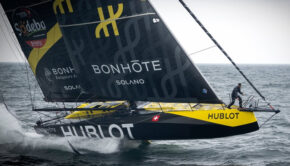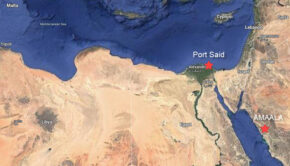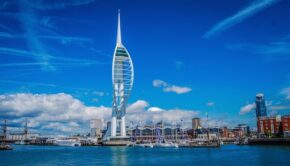Closing in on The Ocean Race 2022-23
Published on September 12th, 2022
In the year since Charlie Enright and Mark Towill’s 11th Hour Racing Team became the first of The Ocean Race IMOCA syndicates to launch their new 60-foot boat, the USA squad has crossed the Atlantic no less than four times and racked up an estimated 20,000 nautical miles aboard the Guillaume Verdier-designed Mālama.
Despite accumulating such an impressive open ocean mileage, according to skipper Enright, it was only after the team’s recent fourth transatlantic that Mālama “finally started to feel like a boat and not a construction project”.
“These yachts definitely have a sweet spot after they are launched, tested, and become reliable,” he said. “We have put a lot of miles on our boat. We have sailed back and forth across the Atlantic and done some other training, as well as the Newport Bermuda Race.”
Enright said that the four Atlantic crossings – including his participation with French training skipper Pascal Bidégorry in the double-handed Transat Jacques Vabre race in November last year – had been key for the team to gather important performance data and to learn vital lessons about how to coax the best out of the US-flagged IMOCA.
Despite having had little time to prepare and subsequently encountering performance limiting keel problems during the Jacques Vabre, Enright said there were still plenty of lessons learned from the race in which despite their issues they finished 13th in the 23-boat field.
“The Jacques Vabre was a case of ‘cross your fingers and hold on’. We had absolutely no time but knew we were better for trying to do it rather than to keep the boat on the dock – because you don’t learn anything there.”
After a period in the shed for scheduled maintenance Mālama returned to the water in May this year for a fully-crewed Atlantic crossing from the team’s French base in Concarneau, France to its US headquarters in Newport, RI.
“We tightened up some of the systems and implemented some new ones and that first transatlantic was about testing all of those, gathering some performance data, and starting to push the boat with confidence,” Enright said.
But there was no pushing too hard. With a whole summer of activity planned in and around Newport Enright – along with crew mates Francesca Clapcich (ITA), Simon Fisher (GBR), and Justine Mettraux (SUI), and onboard reporter Amory Ross (USA) – knew they had to get their boat to the US in good shape.
On the recent return trip, however, Enright said the crew – featuring this time new recruit Jack Bouttell (GBR/AUS) instead of Mettraux – were able at times to ‘let it rip’ in near perfect IMOCA conditions: an average of 20 knots of wind and a favorable sea state. They made the crossing in seven days, 13 hours, and 15 minutes and on the way recorded a 24-hour run of 560.54-nautical miles (nm) [621 miles / 1,037 kilometers].
Although not able to be ratified by the World Sailing Speed Record Council the run surpasses British yachtsman Alex Thomson’s record for yachts 60-foot or less of 539.71 nautical miles at an average speed of 22.49 knots aboard the IMOCA Hugo Boss fully-crewed in the Atlantic in 2018.
It’s an impressive benchmark for the American team but one which Enright is certain will be easily exceeded when the IMOCA fleet sets off fully crewed and in proper race mode on The Ocean Race 2022-23 – such is the potency of the latest generation offshore foiling monohulls.
Enright even suggested that both The Ocean Race 24-hour distance record of 602.51 nm set by team AkzoNobel on the transatlantic leg of the 2017-18 edition, and the outright monohull 24-hour record of 618.01 nm set by the 100-foot US yacht Comanche in 2015, could fall during the 2022-23 race.
“I think the outright record is possible. The thing is you don’t need that much wind. I think those records are on the table in 18-22 knots of wind if you have no maneuvers and flat water – like maybe coming out the Doldrums when you are headed towards Brazil.
“It has a lot to do with the sea state because at 60 feet these boats are either fitting in between the waves or they’re not. That extra length that a hundred like Comanche has buys you the ability to put up big numbers in bigger sea states. But when the sea state cooperates the sky’s the limit for the IMOCAs and from a top end speed perspective these boats can do it.
The faster the boats go, however, the more difficult life on board becomes for the sailors. Although Mālama features an enclosed cockpit to give the crew protection from the elements Enright said that life on board when the boats is in fast and furious mode is ‘pretty heinous’ and was a factor that would inevitably take its toll on the sailors during the race.
“It’s the slamming, it’s the banging, it’s the stopping, it’s the starting, it’s the cramped quarters, that make it a tough slog. We talk a lot about the reliability of the boats, but the question of the reliability of the humans is not to be underestimated. We have been working a lot on injury prevention and just being able to come to work every day. Some sailors’ best ability might end up being their availability, if you know what I mean.”
Ocean racing purists may turn up their noses at the thought of the IMOCA crews spending most of their time inside their boats as they race around the world. However, Enright said the sailors will still have to be at the top of their game and will largely rely on their innate sailing skills to get the most out of their high-tech boats.
“In some ways it’s very different: you are inside, you have got a bot [autopilot] driving, and you are surrounded by a lot of electronics, a lot of computers – all that stuff. But you know, the difference of three knots of boat speed can still be 250 mill different trim on the headsail sheet – that part’s not gone. You have got to balance: you’ve got to be a sailor and you have got to be fast – it’s just different.”
The team was on a busy schedule during its two-month summer visit to Newport but according to Enright the workload was as enjoyable as it was challenging – particularly being able to draw attention to the important topic of ocean health.
“It’s enjoyable, it’s humbling. We are the luckiest people in the world because our job is to talk about something that we’re extremely passionate about in ocean health and as it relates specifically to Narragansett Bay and our own home coastal community. It’s rewarding and it’s easy to immerse yourself in that.”
As well as spreading the team’s sustainability and ocean health messaging Enright said it was satisfying to introduce American sailing fans to their latest generation IMOCA yacht and to spark some anticipation for The Ocean Race’s return to Newport as a stopover for the third consecutive edition in May next year.
“It’s obviously a ravenous sailing fan base and people are very, very intrigued by the IMOCAs. People are psyched. Certainly, in the last six months with more entries coming online and in the pipeline and our visits to town, people are getting fired up.”
After some tender love and care for Mālama from the shore crew after the recent high-speed Atlantic crossing the 11th Hour Racing Team IMOCA will be back in action for the Défi Azimut regatta in Lorient, France next week, followed by two, week-long, blocks of training at the nearby Pôle Finistère Course au Large training center in Port la Forêt, and a final two-week period in Concarneau. After all that it will be time to head for Alicante, Spain in December for the assembly period prior to the race start on January 15, 2023.
Right now the team is waiting to take delivery of some new foils and sails which will need to be signed off prior to the race start.
“Hopefully it’s just a case of put it up, check the box, sign it off. In terms of opportunities to make changes between now and the start of the race, six months isn’t a lot of time. We know we can’t make any wholesale changes at this stage – but nor can anyone else.”
“Now, I think it’s about getting the best out of what we’ve got. There’s a lot to be gained on the margins and a lot of low hanging fruit still out there. We are not gonna chop the hull in half or change the bow profile or move the keel aft 500 mill or any of that stuff – that ship has sailed – but there is plenty we can do with sail areas and optimizing what we have on board in relation to the boat’s trim and ballast.”
Describing the sailing team he has assembled to race around the world alongside him Enright said he was happy with the blend of experience from both The Ocean Race and the IMOCA worlds.
As well as British sailor Simon Fisher (who won The Ocean Race 2014-15 with Abu Dhabi Ocean Racing) Switzerland’s Justin Mettraux (a veteran of the 2014-15 edition with the all-women Team SCA entry and a race winner with Dongfeng Race Team in 2017-18) and the vastly experienced OBR Amory Ross (who has been part of three previous editions of The Ocean Race), the team has recently recruited Italian double Olympian and 2017-18 race Turn the Tide on Plastic crew member Francesca Clapcich, and most recently Jack Bouttell – who won the 2017-18 edition with Dongfeng Race Team.
Enright did not, however, rule out making any new additions to the 11th Hour Racing Team sailing lineup – especially given the physically demanding nature of the foiling IMOCAs offshore.
“We are going to continue to build out the sailing team because it’s going be a race of attrition, certainly. We only have one extra sailor right now so we will probably need a couple more, plus some depth in the OBR position. There will be some planned rotation, as well as I’m sure, some unplanned rotation, so building up that bench is something that we’re still doing right now.”
Race details – Route – Teams – Facebook
The Ocean Race 2022-23 Race Schedule*:
Alicante, Spain – Leg 1 start: January 15, 2023
Cabo Verde – ETA: January 22; Leg 2 start: January 25
Cape Town, South Africa – ETA: February 9; Leg 3 start: February 26 or 27 (TBC)
Itajaí, Brazil – ETA: April 1; Leg 4 start: April 23
Newport, RI, USA – ETA: May 10; Leg 5 start: May 21
Aarhus, Denmark – ETA: May 30; Leg 6 start: June 8
Kiel, Germany (Fly-By) – June 9
The Hague, The Netherlands – ETA: June 11; Leg 7 start: June 15
Genova, Italy – The Grand Finale – ETA: June 25, 2023; Final In-Port Race: July 1, 2023
* To be confirmed – Prologue: September to December 2022
The Ocean Race (formerly Volvo Ocean Race and Whitbread Round the World Race) will be raced in two classes of boats: the high-performance, foiling, IMOCA 60 class and the one-design VO65 class which has been used for the last two editions of the race. Entries in the IMOCA 60 class will compete for The Ocean Race trophy, while those racing the VO65s will chase the Ocean Challenge Trophy. The 14th edition was originally planned for 2021-22 but was postponed one year due to the pandemic.
Source: The Ocean Race









 We’ll keep your information safe.
We’ll keep your information safe.